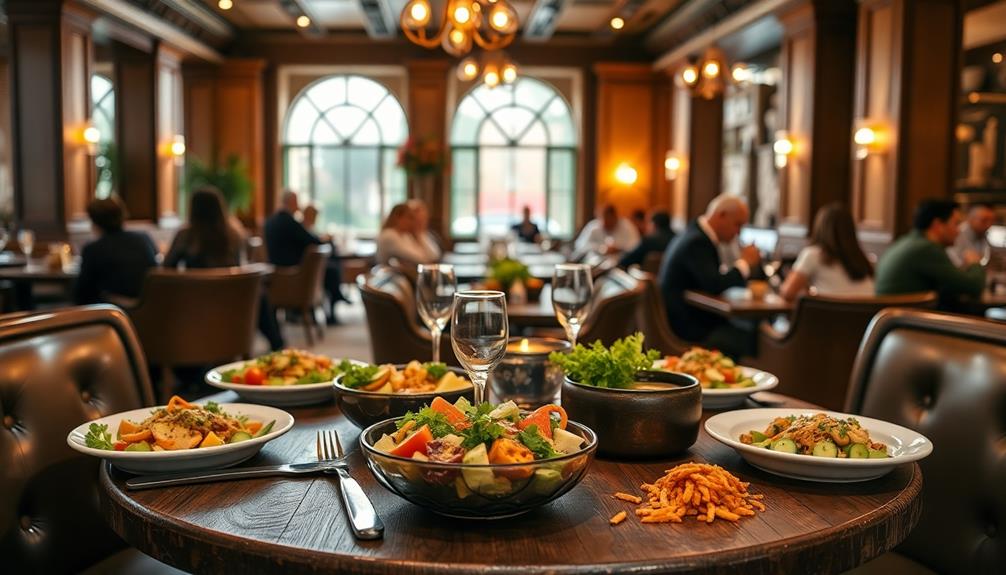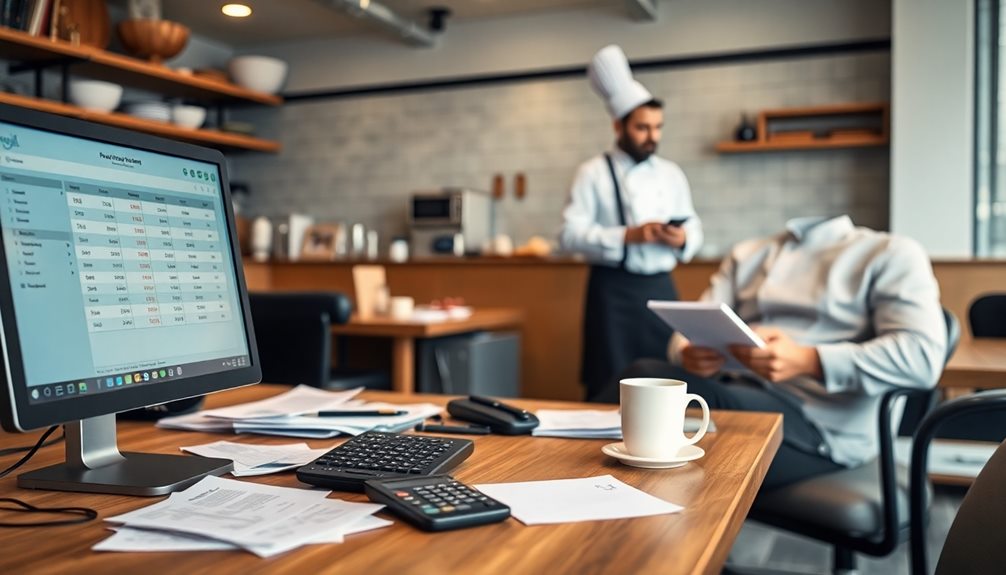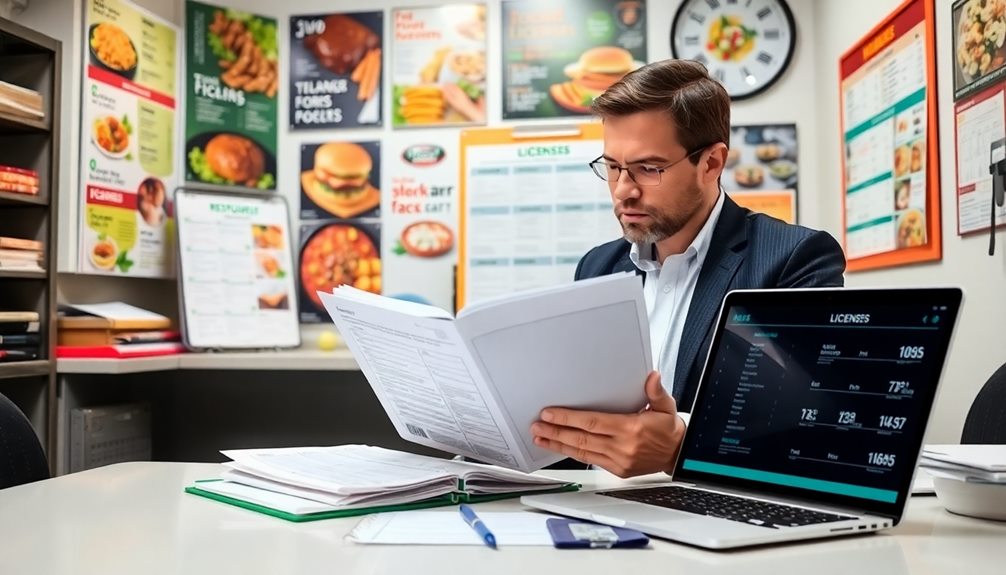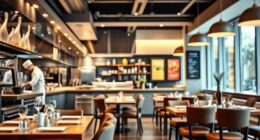Table turnover rate (TTR) measures how often different guests occupy your tables during a specific time. A higher TTR indicates your restaurant is running efficiently, leading to more revenue. To optimize TTR, streamline your menu, train staff for quicker service, and integrate technology like mobile POS systems. Consider managing reservations to prevent empty tables and encourage faster dining without compromising guest experience. Regularly calculate your TTR to identify improvement areas. By adopting these strategies, you can maximize your capacity and enhance customer satisfaction, revealing even more secrets to success along the way.
Key Takeaways
- Table Turnover Rate (TTR) measures how often tables are occupied by different guests, indicating restaurant efficiency and revenue potential.
- To calculate TTR, use the formula: TTR = Total Customers Served / Number of Tables during a specific time period.
- Optimize TTR by streamlining menus to 7-10 items, reducing decision fatigue and speeding up order times.
- Implement technology like mobile POS systems to enhance order processing speed and improve staff communication.
- Regularly assess TTR performance and adjust strategies based on guest feedback to balance speed and quality of service.
Understanding Table Turnover Rate
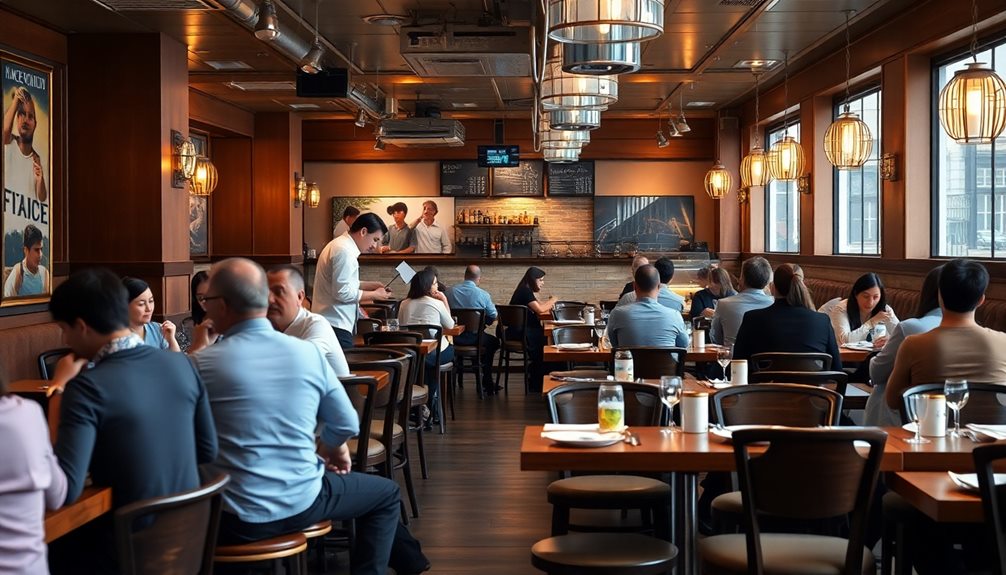
When you think about maximizing your restaurant's efficiency, understanding Table Turnover Rate (TTR) is fundamental. TTR measures how many times a table is occupied by different guests during a specific time period. A higher TTR indicates better restaurant efficiency and greater sales potential. The average restaurant sees a TTR ranging from 1.5 to 3 times per meal period, with family restaurants typically achieving about 3 turnovers during dinner service.
You can optimize table turnover by focusing on factors like layout, menu complexity, and staff efficiency. These elements influence service speed, directly impacting customer satisfaction. For instance, if you serve 120 parties at 30 tables, your TTR would be 4, demonstrating impressive efficiency.
However, balancing TTR with the dining experience is critical. While increasing turnover can boost revenue, prioritizing speed over guest comfort may lead to negative dining experiences and lower customer retention.
It's essential to find that sweet spot where you enhance restaurant efficiency without sacrificing the quality of each guest's experience. By understanding TTR, you can make informed decisions that benefit both your bottom line and your patrons' satisfaction.
How to Calculate TTR
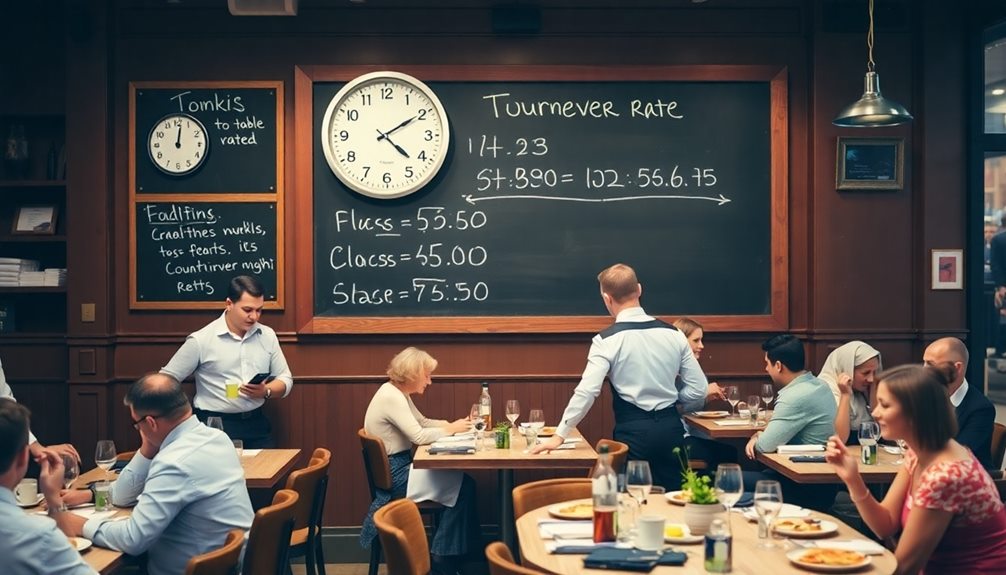
Calculating Table Turnover Rate (TTR) is straightforward and essential for understanding your restaurant's performance. To calculate TTR, use the formula: TTR = Total Customers Served / Number of Tables available during a specific time period.
Start by selecting a meal period, like lunch or dinner service, and count the total number of customer parties served during that time.
For example, if you serve 150 parties at 30 tables during a dinner shift, you'd calculate TTR as 150 / 30, resulting in a TTR of 5. This means each table turned over five times that evening.
It's important to note that the average industry TTR typically falls between 1.5 to 3 times per meal period, with casual dining averaging around 3.
Regularly calculating TTR helps you assess efficiency and pinpoint areas for improvement in service speed and customer flow. By monitoring TTR, you'll gain insights into how well you're utilizing your tables and how effectively you're serving customers, which can ultimately lead to better overall performance in your restaurant.
Key Factors Affecting TTR
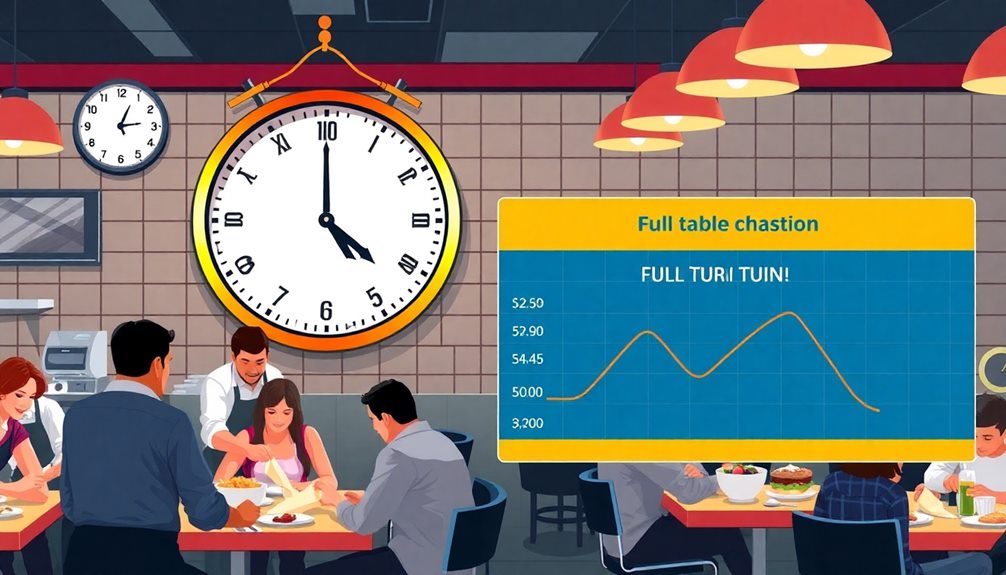
Table turnover rate (TTR) hinges on several key factors that can greatly influence your restaurant's efficiency and profitability.
First, operational efficiency plays a vital role; an ideal layout and size can facilitate faster service and reduce wait times for customers.
Next, consider menu complexity. A streamlined menu with 7-10 quick-preparation items minimizes decision fatigue, allowing for quicker ordering and positively impacting TTR.
Staff training is equally important. When your team is well-trained, they can take orders and clear tables swiftly, enhancing service speed and directly influencing the table turnover rate.
Additionally, understanding customer behavior is essential. By managing guest expectations and informing them about time constraints, you can encourage quicker dining experiences.
Lastly, technology integration can greatly boost your TTR. Implementing mobile POS systems and digital menus expedites order processing and payment, which reduces the time customers spend at the table.
Impact on Restaurant Revenue
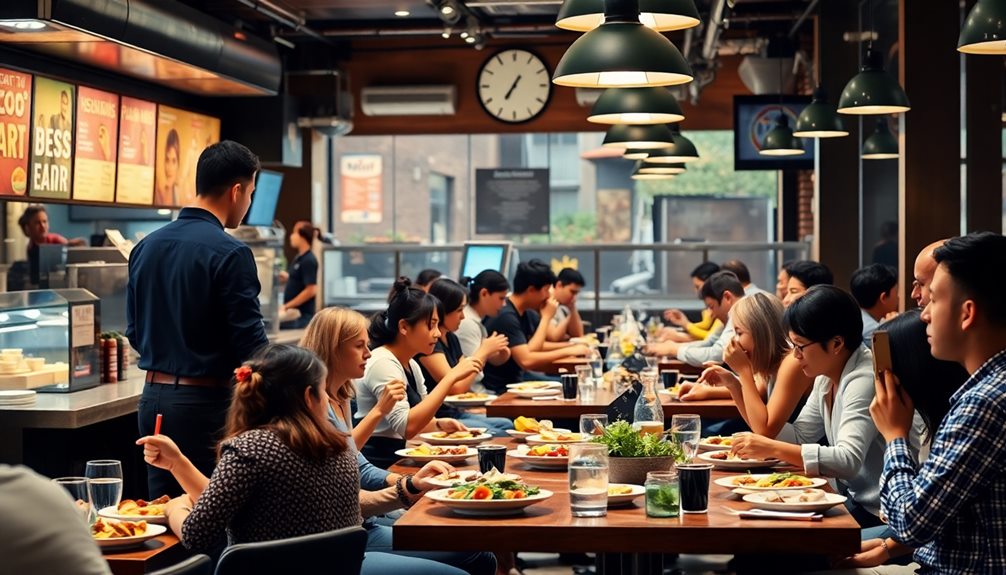
Optimizing table turnover rate (TTR) directly boosts your restaurant's revenue by allowing you to serve more customers in the same timeframe. When you increase table turnover, you're effectively maximizing your capacity. For example, if your restaurant achieves six table turns at an average of $20 per customer, your revenue jumps to $120, compared to just $100 with five turns.
Fast food restaurants often excel in this area, achieving TTRs of 12-24 turns in a single day, demonstrating the considerable financial impact of high turnover. By reducing average dining time through optimizing service processes and menu design, you can enhance TTR without incurring extra operational costs.
Finding the table turnover sweet spot is essential; it allows you to serve more customers while maintaining a pleasant dining experience. Effective management of TTR can lead to a 15-30% increase in restaurant revenue, highlighting the significance of focusing on efficiency.
Balancing Speed and Quality
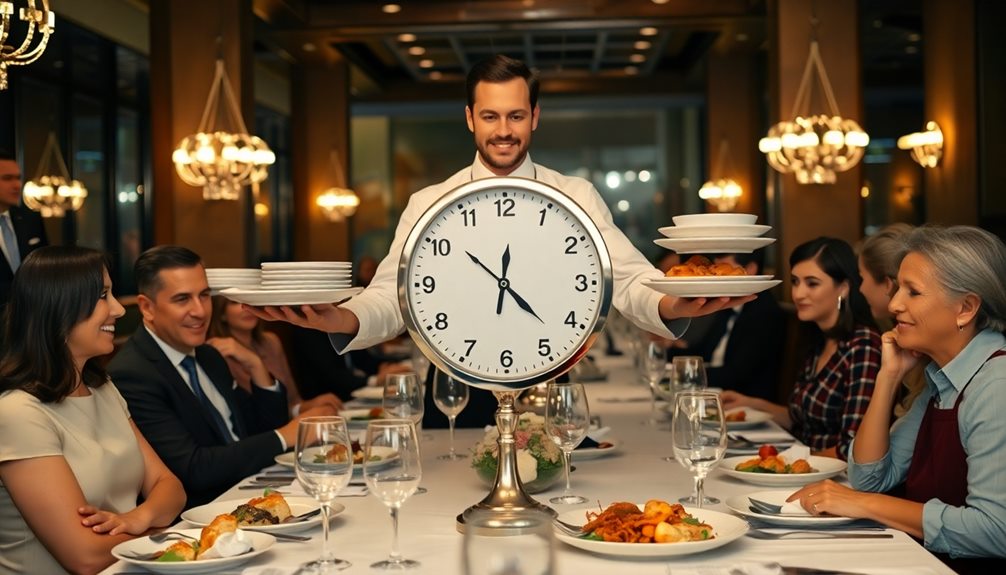
While you want to boost table turnover rates, it's vital not to compromise on the quality of the dining experience. Engaging with your guests and delivering a memorable experience can lead to repeat visits and positive word-of-mouth, which is invaluable for your establishment.
If guests feel rushed, customer satisfaction can decline, impacting your reputation. Effective staff training is essential; studies show it can enhance service speed by up to 30%, allowing for quicker table turnover without sacrificing service standards.
Effective public speaking training can also enhance staff confidence in delivering exceptional service.
A streamlined menu design can help. By offering 7-10 items per category, you reduce decision-making time, enabling faster orders and service while maintaining food quality. This focused approach not only simplifies choices for customers but also allows staff to master the preparation of each dish, ensuring consistency in flavor and presentation. Additionally, it aligns with how restaurants set menu prices, as a more concise menu helps manage inventory costs and minimize waste. By optimizing both the customer experience and operational efficiency, a well-curated menu becomes a win-win for diners and business alike.
Additionally, actively seeking and responding to guest feedback can greatly improve both turnover rates and customer satisfaction. In fact, 70% of diners prefer a speedy experience that doesn't skimp on service quality.
Utilizing technology like mobile POS systems can further optimize table turnover by reducing order processing time by 20%. This empowers your servers to deliver quick service while maintaining the overall dining experience.
Balancing speed and quality is achievable; focus on training, menu design, and technology to guarantee your guests leave happy and ready to return.
Industry Benchmarks for TTR
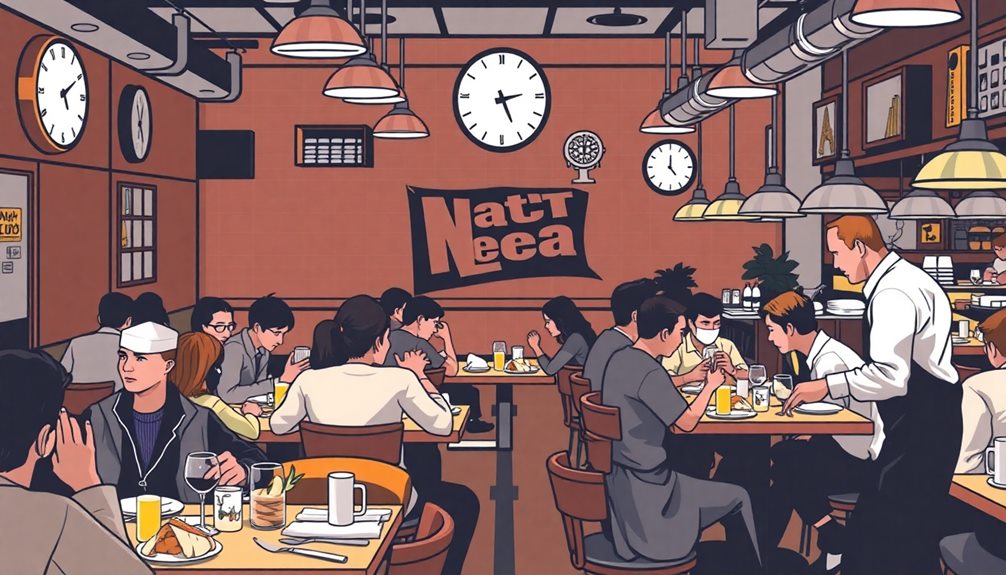
Understanding industry benchmarks for table turnover rate (TTR) can help you evaluate your restaurant's performance and identify areas for improvement. The average table turnover rate varies considerably across different restaurant types, influenced by factors like service style and customer demographics.
Here's a quick look at the average TTR for various dining establishments:
| Restaurant Type | Average TTR (turns/table) | Service Style |
|---|---|---|
| Fast Food Restaurants | 12 – 24 | Quick, efficient |
| Casual Dining | 8 – 16 | Balanced experience |
| Fine Dining | 4 – 8 | Leisurely, upscale |
Industry benchmarks suggest that a TTR of around 1.5 to 3 times per meal period is standard across all restaurant types, with an overall average of approximately 3. By evaluating your TTR against these benchmarks, you can better understand how to optimize table turnover and ultimately enhance your restaurant's efficiency. Knowing where you stand will empower you to make necessary adjustments that fit your unique service style and customer base.
Strategies for Improving TTR
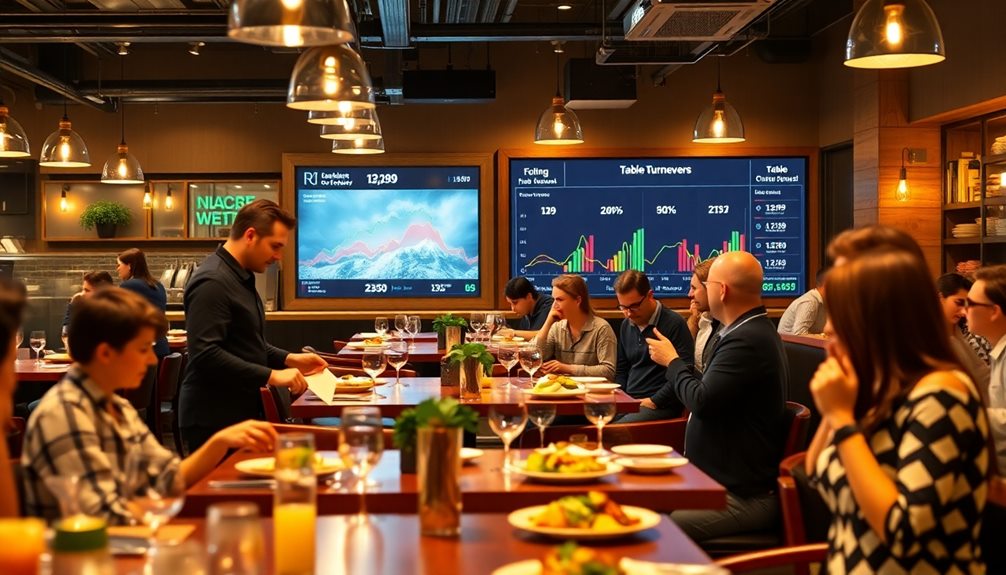
Improving your table turnover rate (TTR) starts with implementing effective strategies that streamline the dining experience. One key approach is menu optimization. By limiting your offerings to 7-10 items per category, you can reduce decision fatigue, leading to quicker ordering and an improved table turnover rate.
Another effective strategy is to implement a structured reservation management system. This includes avoiding seating incomplete parties and confirming reservations, which helps reduce wait times and delays.
Additionally, invest in staff training to guarantee your team greets customers and takes orders within 2-3 minutes, enhancing overall service.
Utilizing mobile POS systems can also greatly cut down dining duration. Some establishments have reported reducing dining time from 25 to 15 minutes, allowing for more table turns.
Moreover, establishing clear dining time limits, such as a 90-minute occupancy policy, can help manage guest expectations while still maintaining customer satisfaction.
Menu Design Considerations
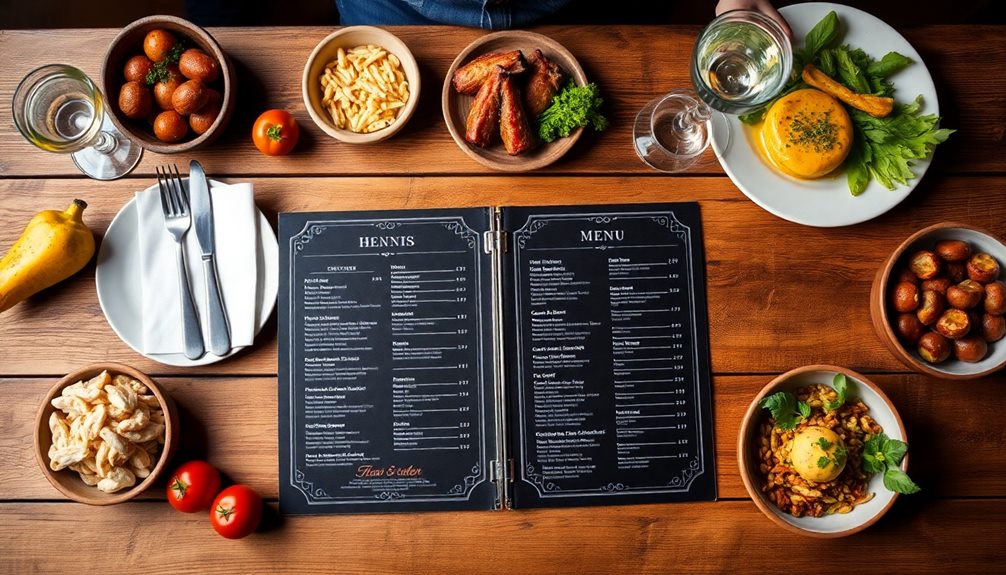
To maximize table turnover rates, your menu design plays an essential role. A streamlined menu with 7-10 items per category helps reduce decision fatigue, allowing your guests to place orders quickly.
Highlighting daily specials and popular menu items can further facilitate faster decision-making, leading to quicker service and increased customer satisfaction.
Regularly updating your menu keeps offerings fresh and exciting, encouraging repeat visits that can boost turnover rates.
Consider pre-prepping menu items like sauces and sides; doing so can greatly reduce wait times during service, enhancing your operational efficiency.
Utilizing digital menus is another effective way to optimize table turnover. They allow for quicker customer ordering and minimize checkout wait times, streamlining the entire dining experience.
When guests can easily navigate your menu and place their orders, they're more likely to eat and leave promptly, which ultimately improves your table turnover rate.
Role of Technology in TTR
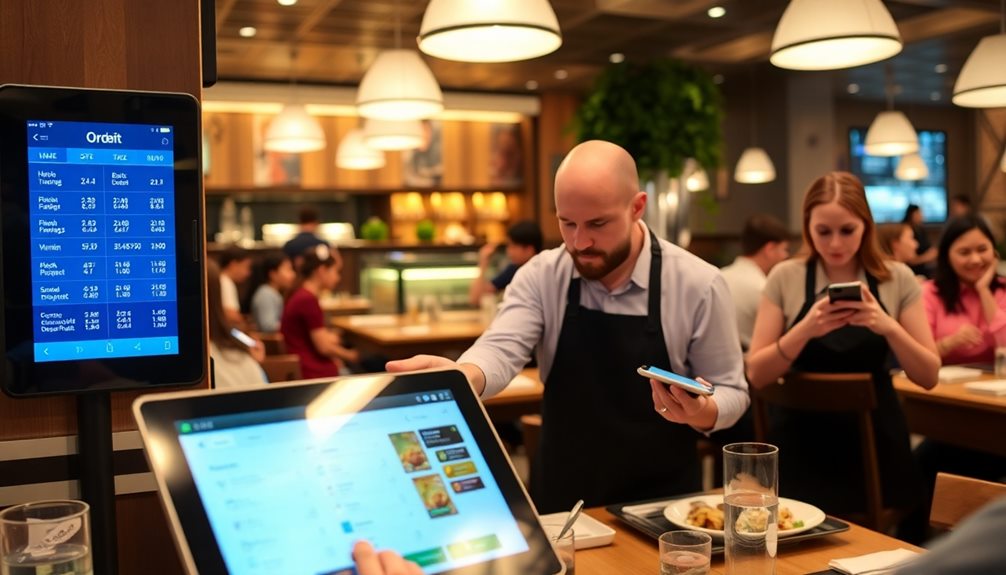
When you adopt digital ordering solutions, you'll see a noticeable boost in efficiency at your restaurant.
By leveraging data-driven decision-making, you can identify trends in customer preferences and optimize your menu accordingly.
A streamlined POS system not only speeds up order processing but also enhances communication among staff.
Together, these technologies can greatly improve your table turnover rate, leading to happier customers and increased revenue.
Digital Ordering Solutions
Digital ordering solutions are revolutionizing the way restaurants enhance their table turnover rates. With tools like mobile apps and QR code menus, you can considerably cut down order processing time by up to 30%.
Credit cards play a considerable role in facilitating these faster transactions. Imagine a dining experience where:
- Faster Service: Handheld POS systems let servers take orders and process payments tableside, reducing dining time by 10-15 minutes per table.
- Efficient Transactions: Restaurants utilizing contactless payment options enjoy a 63% faster transaction speed, making it easier for guests to settle their bills and free up tables.
- Smart Management: Online ordering and reservation management systems help predict busy periods, optimizing seating and guest flow to increase turnover.
Additionally, kitchen display systems streamline communication between your front-of-house and kitchen staff, minimizing order errors and speeding up preparation times.
POS System Efficiency
Efficiency in point-of-sale (POS) systems plays an essential role in optimizing table turnover rates (TTR) for restaurants. By incorporating mobile POS systems, you can take orders and process payments directly at the table, considerably reducing transaction times. This not only enhances table turnover but also improves guest satisfaction.
| Feature | Benefit |
|---|---|
| Mobile POS Systems | Reduce transaction times at tableside |
| Kitchen Display Systems (KDS) | Improve order accuracy and efficiency |
| Contactless Payment Options | Speed up bill settling by up to 63% |
With advanced analytics from your POS system, you can gain insights into peak dining times and customer preferences, allowing you to optimize staffing levels effectively. Additionally, integrating digital waitlist management helps in managing guest flow, reducing wait times during busy periods.
Enhancing Customer Experience
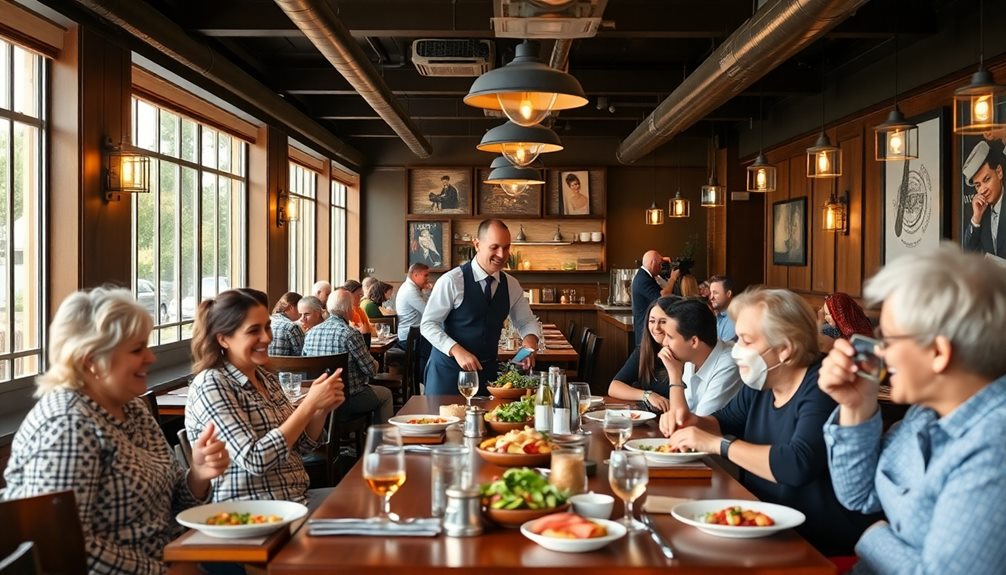
To enhance your customers' experience, clear communication strategies are essential.
When you provide pre-ordering options, you not only reduce wait times but also set the right expectations for your guests.
This approach can lead to greater satisfaction and quicker table turnover, benefiting both your restaurant and patrons.
Clear Communication Strategies
Clear communication is vital for creating a positive dining experience and managing guest expectations. When you clearly outline table policies and expected wait times right at the start, it sets the tone for a smooth visit.
Here are three strategies to enhance your communication:
- Inform Guests Promptly: Let guests know about time limits during busy periods to encourage quicker ordering and dining.
- Update Regularly: Keep your guests informed about their table status, especially during peak hours. This fosters a sense of attentiveness and satisfaction.
- Utilize Signage: Use clear signs to guide guests to available seating quickly, reducing wait times and improving customer flow.
Investing in staff training is essential. By training your team to communicate menu specials and popular items effectively, you can facilitate faster decision-making.
This not only leads to a better dining experience but also boosts table turnover rates.
With these clear communication strategies, you'll guarantee your guests feel valued and their expectations are met, paving the way for fast table turnover and enhanced customer satisfaction.
Pre-Ordering Options
Enhancing the dining experience goes beyond just communication; pre-ordering options play a significant role in streamlining service and boosting satisfaction. By allowing guests to select their meals before arriving, you can reduce wait times by up to 30% and improve table turnover rates. An online pre-ordering system organizes kitchen workflow, ensuring meals are ready as soon as guests arrive.
Consider the following benefits:
| Benefit | Impact |
|---|---|
| Reduce Wait Times | Up to 30% less time waiting for meals |
| Increase Customer Visits | 15-20% more diners during peak hours |
| Customize Orders | Personalizes the dining experience |
| Improve Table Turnover | Faster service leads to more table turns |
| Boost Customer Satisfaction | Convenience enhances overall dining joy |
Implementing pre-ordering options not only enhances customer satisfaction but also minimizes delays, allowing your staff to serve more guests efficiently. With a streamlined dining experience, you can expect happier customers who are more likely to return. Focus on these strategies, and watch your table turnover rate soar while keeping your patrons delighted!
Frequently Asked Questions
How to Improve Table Turnover Rate?
To improve table turnover rate, streamline your menu, utilize mobile POS systems, establish time limits during peak hours, train staff for rapid service, and analyze data to optimize staffing and anticipate busy periods.
What Is Table Turnover Rate?
Table turnover rate measures how often you fill your tables with different guests during a specific time. It reflects your restaurant's efficiency and can greatly impact your revenue potential and overall customer experience.
How Do You Explain Turnover Rate?
You'd think turnover rate just measures change, but it's really about how often you serve new guests at your tables. It reveals your restaurant's efficiency and impacts both revenue and customer satisfaction markedly.
How Do You Manage Seating Arrangements to Ensure Efficient Table Turnover and Optimal Guest Satisfaction During Peak Dining Hours?
To manage seating effectively, you strategically assign tables based on party size, implement a no incomplete parties policy, and monitor arrangements closely. Encourage quick dining while communicating time limits to enhance guest satisfaction during peak hours.
Conclusion
Just like a well-tuned orchestra, your restaurant thrives when every element plays in harmony. Optimizing table turnover rate isn't just about speed; it's about creating a symphony of efficiency and delight. When customers feel valued and satisfied, they'll return, bringing friends along for the encore. So, embrace the rhythm of your service, fine-tune your strategies, and watch as your tables transform from mere surfaces into stages of memorable experiences, ensuring your restaurant's success sings loud and clear.

